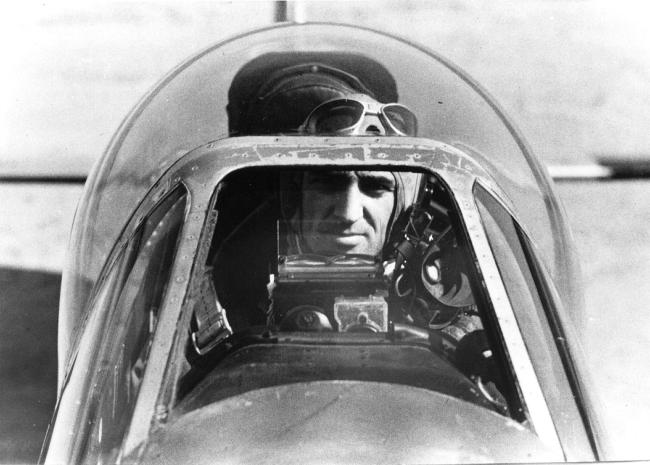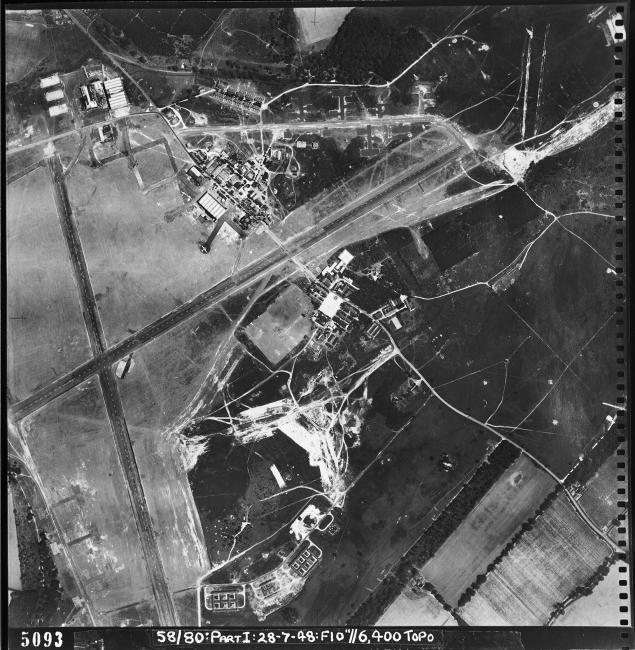Martlesham Heath
Airfield
IWM, Roger Freeman Collection
Object Number - FRE 2958 - Martlesham Heath, the home of the 356th Fighter Group.
Opened in 1917 as home to the RFC Aeroplane Experimental Unit, Martlesham Heath became well known during the 1920s-30s as home to the Aeroplane and Armament Experimental Establishment. Used as an RAF fighter station from 1939, with only a grass airfield, it was selected to become an Eighth Air Force fighter base in 1942. Developed in 1943 with two experimental, soil stabilising, oil and tar mixture runways, it had 70 aircraft dispersals, 20 steel mesh mat plus 50 PSP squares. There were one A, one G, one GS and three blister hangars. The 356th Fighter Group, equipped first with
P-47s and then with P-51s, occupied the station from October 1943 to November 1945, after which it was returned to the RAF. During 1946 to 1960, the station was used again by fighter squadrons, and then by a variety of special units, until the airfield closed in 1961. The site was sold in 1963 and has since become mainly an industrial and housing extension to Ipswich, including Suffolk Police headquarters and Adastral Park (previously the Post Office Research Station). The Control Tower is preserved as a Museum by the Martlesham Heath Aviation Society.
Connections
See how this entry relates to other items in the archive by exploring the connections below.
Detailed History
The restored Control Tower is now the home of the Martlesham Heath Aviation Society Control Tower Museum.
English Heritage's Record Description
A military airfield, used in both World Wars and post-war to 1963. The airfield was initially opened in 1917 as the base for the Aeroplane Experimental Unit. In 1922 a fire damaged part of the technical buildings and the airfield was subsequently rebuilt. In the interwar years both civil and military aircraft were tested. Early in the Second World War the war the test function was moved to a safer site and the airfield was used for intercepting enemy aircraft over the sea with fighter aircraft (including 17, 29, 504, 85 and 151 squadrons). It was also used by squadrons of 11 Group during the Battle of Britain. In 1943 the site was redeveloped for use by the 356th Fighter Group of the United States 8th Army Air Force as Station 369. This included hard surface runways being laid down. The redeveloped site included a control tower on the west side (now housing a museum opened in 2000) with an ammunition dump and fuel store to the south of the flying field. The pre-war RAF camp and 1917 hangars were on the north-east side. Opposite this to the south of the main runway were technical buildings around a main square. Post-war some of the experimental functions of the airfield were resumed. The main runway was extended further. Part of the experimental work for Britain's nuclear deterrent was carried out here. The RAF left the site in 1963, since then the airfield has been mainly used for commercial industrial purposes and has been mainly built over.
People
- Military/Civilian/Mascot: Military
- Nationality: American
- Unit: 356th Fighter Group 360th Fighter Squadron
- Service Numbers: O-798226
- Highest Rank: First Lieutenant
- Role/Job: Fighter Pilot
- Military/Civilian/Mascot: Military
- Nationality: American
- Unit: 356th Fighter Group 360th Fighter Squadron
- Service Numbers: O-815631
- Highest Rank: Second Lieutenant
- Role/Job: Fighter Pilot
- Military/Civilian/Mascot: Military
- Nationality: American
- Unit: 356th Fighter Group 360th Fighter Squadron 361st Fighter Squadron
- Service Numbers: O-762201
- Highest Rank: Captain
- Role/Job: Fighter Pilot

- Military/Civilian/Mascot: Military
- Nationality: American
- Unit: 356th Fighter Group 359th Fighter Group 359th Fighter Squadron Headquarters (359th Fighter Group)
- Service Numbers: O-406504
- Highest Rank: Lieutenant Colonel
- Role/Job: Fighter Pilot
- Military/Civilian/Mascot: Military
- Nationality: American
- Unit: 356th Fighter Group 360th Fighter Squadron
- Highest Rank: First Lieutenant
- Role/Job: Fighter Pilot
Aircraft

- Aircraft Type: P-47 Thunderbolt
- Nicknames: Kathleen Ann
- Unit: 356th Fighter Group 360th Fighter Squadron
- Aircraft Type: P-47 Thunderbolt
- Unit: 356th Fighter Group 360th Fighter Squadron
- Aircraft Type: P-47 Thunderbolt
- Unit: 356th Fighter Group 360th Fighter Squadron

- Aircraft Type: P-47 Thunderbolt
- Nicknames: Butch II Eager Eddie Portland Rose
- Unit: 353rd Fighter Group 356th Fighter Group 405th Fighter Group 352nd Fighter Squadron 361st Fighter Squadron 509th Fighter Squadron

- Aircraft Type: P-47 Thunderbolt
- Nicknames: Elizabeth Miss Carriage
- Unit: 353rd Fighter Group 356th Fighter Group 367th Fighter Group 350th Fighter Squadron 361st Fighter Squadron
Revisions
The name of the organisation when at Martlesham was the "Aeroplane and Armament Experimental Establishment".
The name changed to "Aircraft and Armament Evaluation Establishment" in 1992.
See The National Archives, https://discovery.nationalarchives.gov.uk/details/r/C551
Barry Anderson, Army Air Forces Stations (Alabama, 1985) / Roger Freeman, Airfields of the Eighth Then And Now (London, 1978)
Roger Freeman, Mighty Eighth War Manual (2nd edn, London, 2001)
Michael Bowyer, Action Stations 1: Wartime Military Airfields of East Anglia 1939-1945 (Cambridge, 1979)
http://en.wikipedia.org/wiki/RAF_Martlesham_Heath


![Ground crew of the 356th Fighter Group congratulate the pilot of a P-47 Thunderbolt nicknamed "Zombie" at Martlesham Heath air base. Handwritten caption on reverse: 'ZOMBIE yellow, black outline. [illegible text] black white common practice of 361st FS.'](https://assets.americanairmuseum.com/s3fs-public/styles/max_650x650/public/freeman/media-377162.jpg?itok=mPZN0Ow5)








